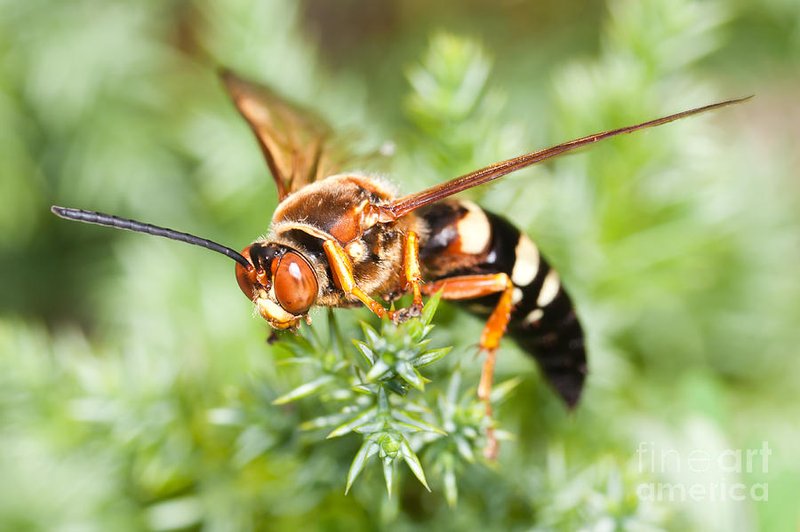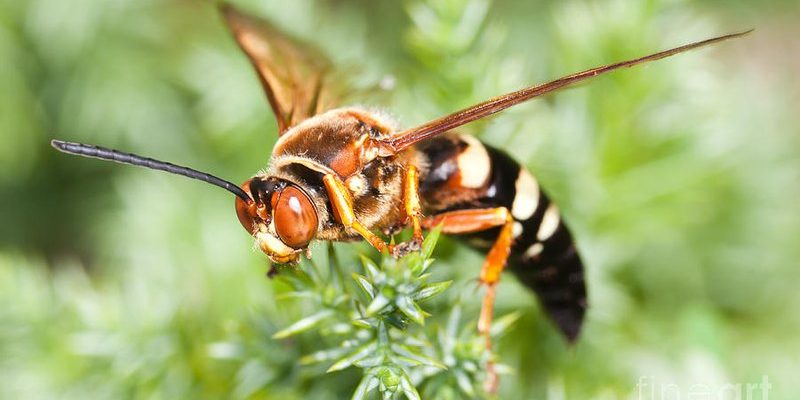
When you think of wasps, you might picture annoying little insects buzzing around your picnic, but the Cicada Killer Wasp is a different breed altogether. These remarkable creatures are not just aggressive hunters; they also have a fascinating life cycle and unique behaviors that make them worth knowing about. Imagine a tiny gladiator, ready to take on much larger foes. That’s what the Cicada Killer Wasp does, targeting cicadas as its primary food source. But before you worry about these wasps invading your backyard, let’s dig into what makes them so intriguing.
In this article, we’ll explore everything you need to know about the Cicada Killer Wasp, from its physical characteristics to its habitat, behavior, and more. Whether you’re a nature enthusiast or just curious about the buzzing inhabitants of your garden, this guide will offer you a comprehensive look at these impressive wasps.
What is a Cicada Killer Wasp?
The Cicada Killer Wasp belongs to the family Sphecidae and is known scientifically as Sphecius speciosus. These formidable insects are primarily found throughout North America, particularly in areas where cicadas thrive. What sets them apart from other wasps is their size; they can be quite large, with some reaching up to 2 inches in length. Their striking black and yellow coloration makes them easy to identify, but don’t let that beauty fool you—these wasps have a fierce side.
Unlike many other wasps, Cicada Killers are solitary wasps, meaning they don’t live in colonies. Each female builds her own nest, often in sandy soil or along gravel paths. After hunting down cicadas, she brings them back to her burrow, where she lays her eggs inside them. This is where things get a little bit eerie; the larvae feed on the live cicadas, ensuring a fresh meal for their development. It’s a dramatic depiction of nature’s cycle of life and death.
Physical Characteristics
Cicada Killer Wasps are quite impressive in size, making them one of the largest wasp species in North America. They typically measure between 1.5 to 2 inches long, with female wasps being larger than males. Their bodies are robust, with a distinctive combination of black and yellow stripes that may remind you of a bumblebee, but don’t be fooled—their behavior is much more aggressive.
These wasps have powerful jaws, which they use to grab and subdue cicadas. Their wings are large and translucent, allowing them to fly at impressive speeds. When you observe them in flight, you might notice their distinctive flying patterns as they dart back and forth, hunting for their prey.
Habitat and Distribution
The Cicada Killer Wasp prefers well-drained sandy soils, making areas like lawns, gardens, and even construction sites ideal for nesting. They often dig burrows that can be several feet deep, which makes them somewhat challenging to spot. You might be wondering why they thrive in these areas—and the secret lies in the availability of cicadas, their primary food source. You’ll typically find them active during the warmer summer months when cicadas are most abundant.
Geographically, you can find Cicada Killer Wasps mainly in North America, extending from southern Canada down to Texas and Florida. They are most prevalent in areas with high cicada populations, which often correlate with abundant greenery and flowering plants. So, if you’re in a region known for its cicadas, chances are good that you’ll encounter these impressive wasps.
Behavior and Diet
The behavior of the Cicada Killer Wasp is as fascinating as its appearance. These wasps are skilled hunters. They hunt adult cicadas using their flight agility and powerful stingers to paralyze them, making them easy to transport back to their nests. It’s a true spectacle to watch them in action! You might see them hovering around trees, searching for cicadas perched on branches or leaves.
When a female Cicada Killer has successfully captured a cicada, she’ll carry it back to her burrow with impressive strength. She then lays an egg on the paralyzed cicada before sealing the burrow. This ensures her larvae will have a fresh meal waiting for them when they hatch. You might think of it as a natural version of meal prep!
Life Cycle of the Cicada Killer Wasp
The life cycle of the Cicada Killer Wasp is a fascinating journey from egg to adult. Once a female lays her egg on a cicada, the egg hatches in a few days, and the larva begins to feed. They consume the cicada’s body, but here’s something interesting: the cicada remains alive during this process, resulting in a very unique and somewhat gruesome meal situation.
As the larvae develop, they go through several stages known as instars. This development usually takes several weeks, depending on environmental conditions. Once they’re fully grown, they pupate within the burrow, transforming into adult wasps. After a few weeks, the adult wasps emerge, ready to begin the cycle all over again. The entire process can take up to two years, which is quite remarkable for such a small creature.
Are Cicada Killer Wasps Dangerous?
While the Cicada Killer Wasp has a fierce reputation, they are generally not dangerous to humans. Their sting can be painful but is not usually life-threatening. Females are the ones with stingers, and they primarily use them to hunt cicadas. Unless provoked, these wasps are more focused on their prey than on bothering humans.
If you happen to stumble upon a Cicada Killer Wasp nest, it’s best to leave it undisturbed. They are not aggressive unless threatened, so observing them from a distance is the best approach. If you’re allergic to wasp stings or feel particularly uneasy, it’s wise to consult a pest control professional for guidance.
Conservation and Ecological Role
Cicada Killer Wasps play an essential role in their ecosystems. By controlling cicada populations, they help maintain the balance of nature. While cicadas can be noisy and overwhelming in large numbers, Cicada Killers help keep them in check. This is crucial for various plants and animals that rely on a balanced food web.
Conservationists emphasize the importance of preserving habitats where these wasps thrive. Urban development can threaten their nesting sites, so creating gardens with sandy soil and plants that attract cicadas can be beneficial. By fostering a healthy environment, we allow these fascinating wasps to continue their vital role in our ecosystems.
Interesting Facts About Cicada Killer Wasps
| Fact | Details |
|---|---|
| Size: | 1.5 to 2 inches long |
| Color: | Black and yellow striped |
| Habitat: | Sandy, well-drained soils |
| Diet: | Primarily cicadas |
| Flight Pattern: | Agile and darting movements |
| Life Cycle Duration: | Up to 2 years |
The Cicada Killer Wasp is more than just a fierce hunter; it’s a critical part of its ecosystem. By understanding their behaviors, habitats, and life cycles, we can appreciate these fascinating creatures rather than fear them. Next time you hear cicadas buzzing or spot a large wasp in your garden, you might just be witnessing nature’s incredible balance in action. Isn’t that something to marvel at?
FAQ
What do Cicada Killer Wasps eat?
The primary diet of Cicada Killer Wasps consists of adult cicadas. Female wasps hunt and capture cicadas, bringing them back to their nests. The larvae that hatch from the eggs feed on these cicadas, which provides the essential nutrients they need to grow and develop.
Are Cicada Killer Wasps beneficial for gardens?
Yes, Cicada Killer Wasps can be beneficial in gardens as they help to control cicada populations. They prey on cicadas, which can become quite loud and overwhelming during their mating seasons. By keeping their numbers in check, these wasps contribute to a healthier ecosystem in your garden.
How can I identify a Cicada Killer Wasp?
Cicada Killer Wasps are relatively easy to identify due to their large size and striking black and yellow coloration. They can grow up to 2 inches long and have a robust body with distinctive markings. Observing their hunting behavior can also help, as they actively search for cicadas during the warmer months.
Do Cicada Killer Wasps sting?
Female Cicada Killer Wasps do have stingers and can sting if they feel threatened. Their sting is painful but not life-threatening for most people. However, if you are allergic to wasp stings, it is advisable to avoid them and consult a healthcare professional if stung.
Where do Cicada Killer Wasps build their nests?
Cicada Killer Wasps typically build their nests in sandy, well-drained soils. You can find their burrows in gardens, lawns, or even near construction sites. The nests are usually solitary, with each female creating her own underground burrow.
How long do Cicada Killer Wasps live?
The lifespan of the Cicada Killer Wasp varies depending on environmental conditions and the stage of life. Adult wasps generally live for several weeks to a few months, while the entire life cycle, from egg to adult, can take up to two years.
Are Cicada Killer Wasps aggressive?
Generally, Cicada Killer Wasps are not aggressive toward humans. They are more focused on their hunting activities and will only sting if they feel threatened. Observing them from a distance is the best way to enjoy their fascinating behavior without causing any distress.
Can I prevent Cicada Killer Wasps from nesting in my yard?
If you want to prevent Cicada Killer Wasps from nesting in your yard, consider keeping your lawn well-maintained and eliminating sandy areas that may be attractive to them. However, it’s important to note that these wasps are beneficial for controlling cicada populations, so allowing them to live peacefully may enhance your garden’s health.
What should I do if I encounter a Cicada Killer Wasp?
If you encounter a Cicada Killer Wasp, the best approach is to remain calm and avoid sudden movements. They are usually focused on hunting and are not inclined to attack unless they feel threatened. Simply observing them from a distance allows you to appreciate their unique behaviors without worry.
Are Cicada Killer Wasps endangered?
Cicada Killer Wasps are not currently considered endangered. However, habitat loss due to urban development can impact their populations. Supporting local ecosystems by planting native flora and creating sandy habitats can help sustain their populations and ensure they continue to thrive in the wild.

